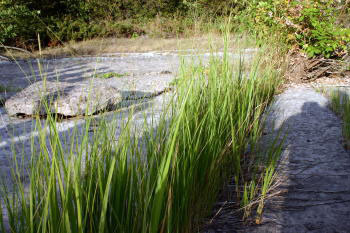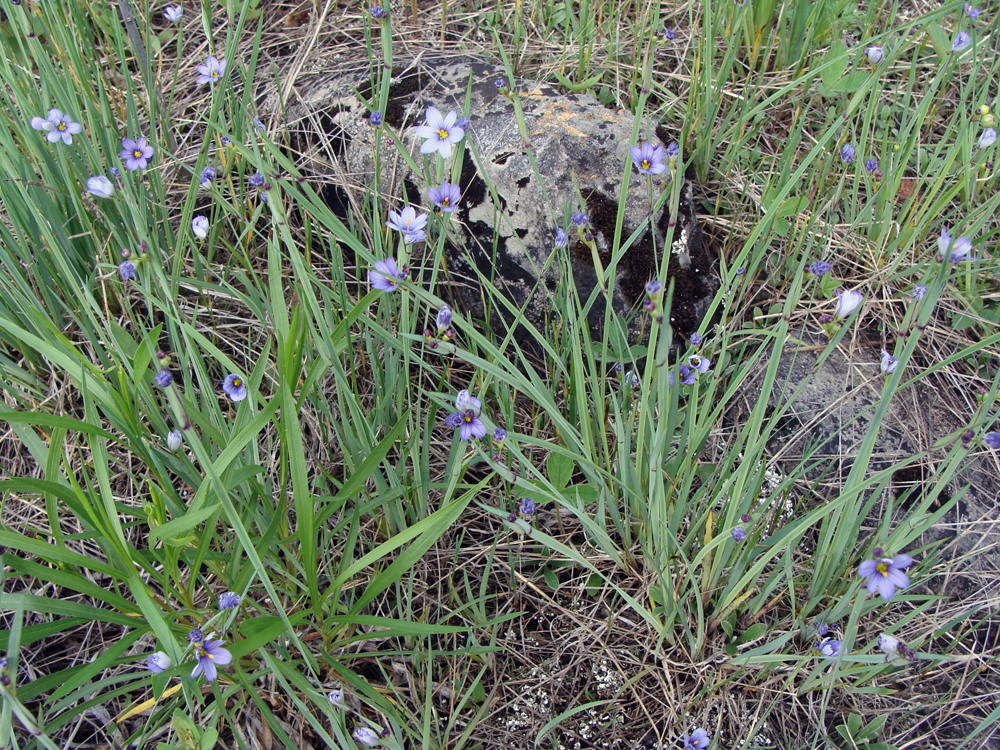Prince Edward County, Ontario, Canada
Backyard Naturalization – Native Grasses
USING NATIVE GRASSES ON YOUR PROPERTY
Environments with full sun, drought-like summers and cold winters are ideal for native grasses. One would have to conclude that this summer provided ideal conditions for prairie grasses, so it seems appropriate to focus on a variety of species as this month’s feature. In the winter, grasses provide cover and nesting habitat for birds and wildlife as they can withstand snow cover. Grasses are slow to green up in the spring but grow fast in the summer, blooming from August to September, then going dormant with the first hard frost. During the fall months, grasses turn a variety of colours and brighten up the surrounding landscape.
Native grasses will provide cover, food and nesting habitat for wildlife, in addition to beautifying your garden. Grasses are great for filling around and in between existing flowering plants and to prevent weeds from becoming established. Native grasses are adapted to local conditions. The roots dig deep into the earth and as a result, grasses can grow in poor soil and require less water than most plants.
Seeds should be planted in late April to May or late November, while young plants can be planted in late May. After planting, the seeds or roots of plants should be covered with soil and mulch. Mulches will help retain moisture, reduce weeds and prevent frost heave over winter. Fertilizer is not necessary and actually encourages weeds. New plants or seeds need water every 3 to 4 days for the first few weeks, but by mid-July should be able to survive on their own. One year old plants (plugs) can be planted anytime and need to be watered regularly for a minimum of two weeks until they are established. Grasses will form their essential deep root system in the first year and weeds will need to be kept under control to give the grasses the room for growth they require. Be sure to purchase seeds/ plants from a nursery where they are legally obtained and grown from seed, not dug up from the wild.
PRAIRIE & MEADOW GRASSES
Big Bluestem Andropogon gerardii
Most aggressive of grasses, this perennial grows 75 cm to 1.5 m in clumps. In flower, August to October, the leaves are a blue-green colour which turn a reddish bronze/russet colour in fall. The flowers look like turkey feet. Grows in all types of soil and moisture regimes. Prefers wet conditions, full sun and is drought tolerant.
Wildlife: Food source for larvae of Dusted, Ottoe and Beard-Grass Skipper butterflies; cover for a variety of wildlife
Other: Native people used it to treat digestive problems; also called Beardgrass, Turkey Claw, Turkey Foot Grass
Indian Grass Sorghastrum nutans
Coarse perennial, aggressive in some soils, but dwindles in competition. Grows 60 cm to 2.7 m in tufts or single stems. Shiny golden brown colour, August to September, turning bronze in the fall as it sheds its seeds. The flowers are initially orange/brown but fade to a grayish brown colour. Grows well in full sun, sandy, well drained soils, but prefers dry to mesic soils.
Wildlife: Seeds eaten by finches & sparrows; cover for a variety of wildlife
Switch Grass Panicum virgatum
Perennial grass grows in leafy clumps up to 2.1 m in full sun. In July-August, flowering stems grow 1.2 to 1.8 m in bunches with wide spreading airy flowers. Purple in colour when in flower turning to gold/tan in fall and a yellow/straw colour over winter. It grows in dry, mesic to wet conditions but prefers good soils. Aggressive in moist soil and great for marshy to dry sites.
Wildlife: Seeds eaten by Cone-Headed Grasshopper in fall, juncos & sparrows in winter; food source for Leanard’s Skipper & Tawny-Edge Skipper larvae; cover for wildlife
Other: Also called Panic Grass
Prairie Cordgrass Spartina pectinata
Tall, coarse perennial 60 cm to 2.1 m, aggressive in wet areas. Flowers July to September, in comb like arrangement. Pale straw colour to deep orange or bright red in drought. Prefers wet sites, good for stabilizing eroding stream banks and edges of ponds and rivers.

Wildlife: Food source for waterfowl
Other: Used for thatching and fuel; also called Freshwater Cordgrass, Ripgut, Slough Grass, Tall Cordgrass
Sideoats Grama Grass Bouteloua curtipendula
Low grass, perennial grows 30 cm to 1m in small clumps/patches. Drought tolerant, withstands grazing & trampling but doesn’t compete well with taller plants. Short red, orange or purple oat-like flower clusters (seeds) hang from one side of the stem in two rows, which rustle in the wind. Bluish-green colour in the summer turning to pale orange/gold colour, sometimes purple/rose colour, in fall. Grows in sun or partial shade on dry sites with clay, sandy or gravelly soil rich in limestone or calcium.
Wildlife: Seeds eaten by juncos and sparrows in winter
Other: Also called Tall Grama Grass
Little BluestemAndropogan scoparius
Tufted, leafy perennial grows 45 cm to 1.5 m in clumps/clusters. Mid-size blue-green grass grows July to October. Single white-hairy elongate flowers form clusters at tips of stalks, with white/silver tufted seeds in October. Leaves turn a tan/bronze-orange to wine red colour after frost. From October to March, it has the deepest red colour of all grasses. Prefers well drained soils, dry to mesic, acid to alkaline conditions. Drought tolerant, great for sunny gardens and poor soil.
Wildlife: Food for Ottoe & Crossline Skipper larvae
Other: Also called Broom Beardgrass, Prairie Beardgrass, Broom or Wiregrass; alternate Latin nameSchizachyrium scoparium
Northern Dropseed Sporobolus heterolepis
Perennial or annual, ornamental grass, low to medium size. Grows 45 cm to 1 m in dense tufts/fountains of narrow, long hair-like leaves. One meter flower stalks emerge in August to October with purple to blackish flowers that have a pungent waxy aroma, similar to hot buttered popcorn. The tufts of grass resemble green to orange pompons in late summer or fall, which turn red in drought years. Grows in dry to mesic conditions in a variety of soils. It provides a nice accent along a walkway or edge of a garden.
Other: Natives made flour from the seeds; also called Prairie Dropseed
Canada Blue-Joint Calamagrostis canadensis
Dense, leafy, adaptable, medium size perennial spreads quickly in disturbed areas. Grows 45 cm to 1 m in clumps or patches on wet sites & up to 2 m in shady sites. Purplish spikelets appear with small flowers from July to September. Leaves are a purple/lead to green colour. Grows on dry or moist sites, with little habitat preference. Prefers full sun to partial shade, in wet,open areas on mineral soil.
Wildlife: Deer, moose & muskrats graze on young shoots; stems provide cover for wildlife in winter
Other: Can transplant to well drained arable land
Porcupine Grass Stipa spartea
Grows in small tufts to a height of 1.2 m from May to July. Flowers grow in narrow arching clusters with papery bracts which enclose sharp pointed seeds with twisted bristle-like awns. These seeds can be drilled into the soil by the twisting awns which can injure livestock. Prefers dry, prairie like sites.
Other: Also called Needle Grass or Needle-and-Thread
Prairie June Grass Kohleria maranta
Low, bunching grass grows up to 60 cm from July to late September. Pale green papery flowers grow in a narrow cylindrical cluster at the tops of the stems. Grows well in dry sandy soil, in open spaces.
Other: Also called Crested Hair-Grass; alternate Latin name Kohleria cristata
PRAIRIE & MEADOW SEDGES & HERBS
Pennsylvania Sedge Carex pensylvanica
Low growing perennial sedge 30 cm in height. Drought tolerant and great as a groundcover. Flowers from May to June with purplish seeds at the tops of stems. Grows well in dry soil in shady areas, but also grows in the sun. .
Other: Easy to start from seed or by division in spring
Plantain-leaved Sedge Carex Plantagenet
Evergreen sedge grows up to 45 cm in height. Purpleflowers from April to June. Grows well in shady, moist woodland areas and is a great groundcover.
Other: Easy to start from seed; seeds in early spring
Common Blue-eyed Grass Sisyrinchium montanum
Tall, erect, tufted, pale green perennial herb grows 30 to 60 cm in clumps. Star shaped violet-blue flowers with yellow centers appear at the tops of stems from May to July. Whitish-green to straw color or pale brown oval or round capsules (seeds) form at the ends of the stems. Prefers moist to average soil with high lime content in sun to partial shade.
Other: Easy to start from seed or by division; member of the iris family

Despite the name, this perennial is not a grass, but actually an herb, belonging to the Iris family. This photo was taken north of Yarker. Photo by Terry Sprague
If you are planning to undertake a naturalization project on your property, I have a number of helpful handouts on species of native shrubs, trees and wildflowers that are recommended for planting. I would be happy to e-mail these handouts in PDF form to you upon request. CONTACT ME